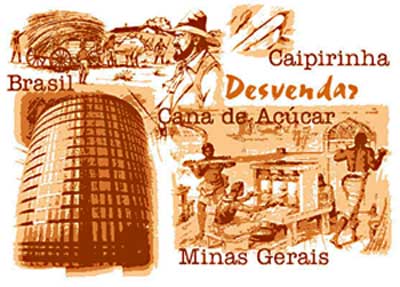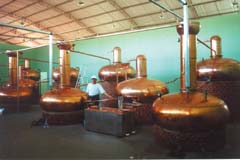Below, advertising
|
How to recognize a good quality cachaça
By Demóstenes Romano, journalist and producer of cachaça.
Note: The article below was published originally by the Brazil Ministry of Foreigner Relations, and, as such, are for public release. Many interesting publications by the MoFR, like this one, never reach the public.
How do you recognize a good cachaça? To begin with, the really good one, different from most found in the market, has a pleasant aroma, "doesn't go down burning", doesn't give you bad breath and doesn't give you a hangover.
Although it is distilled, like whiskey, and not fermented, like wine, a really good cachaça
resembles wine rather than whiskey. Unfortunately few
people are aware of this, and it's
hard to come across stills that
produce the legitimate and
traditional Brazilian drink with the
special quality that every cachaça
should have (as to tradition,
historical records reveal that the
first sugar cane mill in Brazil was
built in 1534, by Martim Alfonso
de Sousa, donee of the Captainship
of São Vicente).
In the rich and little known
universe of cachaça the consumer is immersed in a storm of
commercial information, of
inconsistent opinions almost
always contaminated by the
snobbishness of producers or
consumers, as if the production
and savoring of good cachaça
had to be shrouded in mystery
and exclusiveness .

Before owning my first still,
I did extensive research on
production and consumption of
cachaça in Brazil, visiting many
producers, taking courses,
reading everything I could,
looking up the few universities
that are interested in the subject,
extending many conversations
throughout the Minas Gerais
inland. In this quest I was surprised
to find that the future of cachaça
is promising, even if cloaked in
amateurism, prejudice, marginality
- thus, as in life and business
management, the lower the
evolution stage, the wider the
room for expansion.
If the reader believes he or
she is incapable of producing or
savoring a good cachaça, relax,
this happens even to the best
Brazilian connoisseurs.
If you think you are unversed
in cachaça, know that the
problem is not yours: it is the
misinformation that surrounds cachaça, almost
always disguised in primary vagueness, starting
with the name of the product: cachaça, pinga,
caninha or aguardente? Not to mention the most
common popular synonyms: birita, branquinha,
beggar's blanket, dengosa, uca, tira-teima, mé,
water that birds don't drink, canjebrina.
Since what concerns us here is to provide
some guidelines for production and quality
evaluation, we leave that to the reader's discretion.
To set the context, we are talking about small
scale production of home-made cachaça, because
quantity and quality do not mingle well in this
process, just as there is a huge difference between
preparing good food on a wood burning stove for
ten people or for a hundred people.
In short, this is the traditional process:
1. Sugar cane cultivation - any one of the
hundreds of varieties of sugar cane can be used
to make cachaça. The difference between one or
another is more related to productivity, amount of
juice or sugar content, than to the quality of the
cachaça. And don't forget: no poisons, fire or other
ecologically damaging practices.
2. Milling - the sugar cane is ground, usually in a
conventional mill, in order to extract the juice,
commonly known as garapa. At the milling stage,
two factors have a decisive influence on the degree
of acidity of cachaça: cleanliness and hygiene of
the mill and the time between cutting and milling
the sugar cane (the shorter the time between
cutting, transport and milling, the better).
3. Fermentation – the garapa goes from the mill to
tanks or vats to improve the final product: extra
filtering, leaving it without bits of bagasse or any
solid residues. Every day, the containers receive new
and clean garapa, whose sucrose content must be
about 15 brix (scale that indicates the sucrose level,
measured by a device called sacarimeter) and pH
of 4.8 to 6.0. In the small-scale process of production
of cachaça, using "caipira" fermentation, about 20%
of the container is permanently filled with toasted
ground maize or ground maize and a small amount
of soy bran and rice bran. In the organic nutrients
soaked in garapa, microorganisms proliferate,
among which the yeasts, or eucariot cells,
predominantly saccharomyces and schizosaccharomyces,
which are the most efficient in turning
sucrose into ethanol. The conversion of the sugar
into alcohol provides the transformation of garapa
into must, which is the substance ready for the
distillation phase. In good conditions, fermentation
time varies from 12 to 24 hours, including a
decantation period.

A cachaça is good or not (in flavor, aroma,
lightness, smoothness, the "next day") depending
on each step of the production process. But the
set of steps in the fermentation phase is the most
important and difficult to manage. Just remember
that, in practice, what we call fermentation is the
creation of living beings, yeasts, not visible to the
naked eye, extremely sensitive and demanding as
to feeding schedules (renewal of the naturally sweet
garapa), rest time (decantation), environmental
conditions (temperature of the place, cleanness of
the container, etc.) and conditions for reproduction
and renewal of the cells.
If you have the chance to
visit the premises of a still, prioritize
the vital part where fermentation
is carried out and observe and
ask about five quality indicators
of the process that have a direct
influence on the quality of the final
product:
3.1. when you arrive, take a deep
breath and feel whether the
aroma is of ripe fruits, mild
and pleasant, or if it smells of
alcohol and something stale,
as if something were decomposing
and exhaling acidity.
3.2. check whether there are flies and mosquitoes
in the fermentation room. The presence of
"vinegar flies" (drosophilae) indicates infection
by ascetic bacteria that increase the acidity of
the must and of the final product.
3.3. another indication of the quality of the fermentation
(that is, the creation of yeast) is a
foamy appearance on the surface of the must,
making it look as if it is boiling. It is the action of
the yeast on the sugars, causing the formation
of carbonic gas at the ratio of one molecule of
the gas for each molecule of ethanol. Also with
the naked eye, pay attention: the occurrence
of bubbles is a bad sign (the bigger, the worse)
and a good sign is a movement similar to the
boiling in cooking, specially in making jam.
3.4. ask about garapa renewal schedules, time of
decantation of the must and brix measurement
(sucrose content) of the garapa when it goes
into the vat. The more consistency and
discipline, the better.
3.5. a key question for an important piece of information:
how often is the leavening renewed,
changed, remade? A good quality indicator is
whether it doesn't "weaken", "get ill", or "die"
at least throughout the conventional harvest
period, of about six months. For those who
produce all year round, it should be in good
condition all year round, just needing to be
oxygenized from time to time.
4. Distillation – after feeding on the sugar of the
garapa, the yeasts start turning it into must, making
the sucrose content fall from about 15° Brix to zero.
Then the must without sucrose is left to rest, for
decantation and for the yeasts to "rest", and after
that it is placed in containers called alambiques,
which are huge "pans" that can hold a hundred to
a thousand liters of must.
The distillation of cachaça occurs by heating
(direct fire or boiler) the must that starts to evaporate
when boiling. The vapor goes up into the alambique
and turns into liquid, condensing when it comes in
contact with the bottom of the hood filled with
running cold water.
In this phase of distillation, it is absolutely vital
to remove the first liters of cachaça (this first part is
called "head") that are inevitably contaminated by
elements that are damaging to the health and good
taste of the consumer. After these more volatile
elements are removed, the distillation enters the
stage of production of the best part of cachaça,
which is called "heart". This better quality product
usually represents only about ten percent of the total
must. After the "heart" comes the "tail" or "weak
water", which is as damaging to the consumer's
health and well being as the "head".
This is where it becomes evident that quantity
and quality are incompatible in true home-made and
ethical production of excellent cachaça. The
condition for obtaining an excellent product is not to
mix "heart" with "head" and "tail".
5. Storage and Aging – bottling new cachaça and
placing in the market without aging should be
considered a threat to public health and placing new
cachaça without bottling should be a matter for the
police.
Storing cachaça in barrels, large vats or casks
made of hardened wood makes a huge difference
in flavor and occurrence of volatile elements. In these
circumstances, there are striking differences
between the drink produced on the same day,
stored one month and aged six months, particularly
if the wood is good in terms of pores, age and
oxygen exchange, without interfering with flavor,
such as oak or balsam (in glass the aging process
is very slow, taking years to reach the aging point
that takes months in wood).
How do you recognize a good cachaça? The
answer, without contraindication: trying and being
demanding.
Don't be impressed by labels, folders,
interesting stories: try it and don't drink if it "goes
down burning" and "scratching like a cat's nail".
Don't drink if it smells of alcohol and not sugar cane.
If you notice acidity (vinegar taste or smell),
remember the respect you owe to your digestive
system.
Do not put down your sense of smell and taste
in favor of conditioning and folklore about colored
cachaça or white cachaça, "rosário" or not
"rosário": Dishonest counterfeiters know how to
color or whiten. Trust your capacity to evaluate,
analyze and compare them, as in everything else
that is worthwhile in life.
I'm sorry I can't invite each reader to go to my
still and see the production and try the Cachaça
da Fazenda do Boi Parido. Those who venture will
be welcome.
Back to Top
|
|


